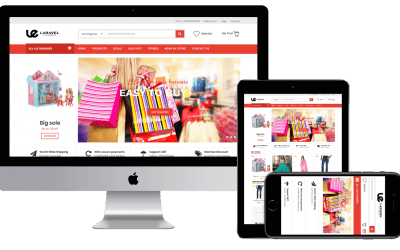Website design software has evolved so it’s easier to use now more than ever. You don’t need to know coding to develop an attractive and functional site. No matter what program you use, there are basic rules and tips that will give your website a professional look, make it easy to find, and show your company in the best light. Here’s our step-by step guide to creating a successful business website.
1. Determine the primary purpose of your website
A business website generally serves as a space to provide general information about your company or a direct platform for e-commerce. Regardless of whether you create a simple website that tells a little about your company or a more complex e-commerce site, the most important thing you must do is say, on the home page in plain terms, what your company does, do not make customers root around to discover if your company can do what they need.
“Think about your specific user experience, and the journey the user will go through as they navigate your site,” added Gabriel Shaoolian, CEO of website design and digital marketing agency. “Whatever the fundamental goal of your website is or whatever the focus may be, users should be easily able to achieve it, and the goal itself should be reinforced as users navigate throughout your site.”
If you don’t plan to accept payments through your website, you won’t have as much work to do in setting it up. If you are a retailer or service provider and want to offer customers the option to pay online, you’ll need to use an external service to receive your payments, which will be discussed later in this article.
2. Decide your domain name
Your domain name is one of the most important features of your website. It’s the URL you’ll be sharing with your current and potential clients and promoting on social media. Therefore, you want it to be descriptive and easy to remember and type in. Try to keep it short, and steer clear of abbreviations, acronyms and numbers if possible, to avoid customer confusion.
You also need to decide your top-level domain, or TLD. This is the suffix at the end of your domain name, such as .com, .net or .biz. However, nontraditional TLD names have grown in recent years. While these can be descriptive, .com is still the default.
Once you’ve selected your domain name, you’ll need to confirm its availability and purchase it through a domain registrar. Don’t forget to check copyrights to make sure you’re not infringing on anyone else’s protected name with your website. If your preferred URL is already taken, you can call the company and ask to buy it from them.
3. Choose a web host
Every website needs a “host,” a server where all of the data is stored for the public to access at all times. As a small business, hosting your own website is simply too large an expense, so you’ll need to select an external host.
Depending on your budget, you can follow two different routes. A shared web host, the least-expensive option, means you’ll share a server with other sites. Dedicated hosting costs significantly more, but it means that you get your own private server and won’t have to compete with other sites that could drag down your speed.
As you grow, you may find that you need to upgrade to a different web host, or even work with multiple providers to handle your website traffic and operations. It is advised keeping a close eye on your site performance and the experience your customers have using your website so you can determine your hosting needs.
4. Build your pages
A good website is more than a static home page. You’ll want to create multiple pages dedicated to different aspects of your business, such as a detailed catalog of your products or services, or a blog section for company updates. As for your overall website, you want to be sure each page supports the primary goal of the website, has a clear purpose and includes a call to action (e.g., learn more, sign up, contact us or buy this).
A contact page, your customers’ direct link to you, is one of the most important sections of a website, so make sure you include as much information as you can (phone number, email address and physical location, if applicable). It’s also a good idea to include information about the founding team or staff on an “About” page to help customers put real names and faces to your brand.
If your business doesn’t already have a logo, hire a graphic designer or create a logo yourself to use on your website, business cards and social media profiles. This will help your clients identify your company quickly and easily on the web.
Justin Zalewski, a design lead at design and innovation consultancy Studio Science, offered a few basic tips to help you create efficient, content-rich pages for your website:
Be clear about what your business does. Distill what your business does into a clear, concise statement and lead with that. Visitors should be able to understand what you do within seconds of landing on your home page. A few well-written pages are more effective than dozens of poorly written ones.
Place strategic calls to action. Call-to-action buttons tend to perform best when they match the information on the page. For example, a “Buy Now” button makes sense on a product page, but not on the About page. Rather a “Contact us to learn more” might be more appropriate. Likewise, a page listing customer reviews might have a button that takes the reader to the available plans and pricing.
Automate speed improvements. Set up as many automated speed improvements as you can. If you use a content management system (CMS), installing the right plugins will cache parts of your site so visitors don’t need to download anything more than once. Some of the more technical aspects of caching and compressing files may require a Web development partner if you’re not particularly tech savvy.
Avoid stock photos. Cheesy stock photography is the quickest way to turn a great site into a mediocre one. If you’re looking for photos to use on your page, it’s best to use a picture of your actual team or office.
Pheil added that high-quality images of the products increase sales, so invest in good photos of the products or services you sell.
5. Set up your payment system (if applicable)
While this step won’t apply to all business websites, companies that want to offer the option to pay online will need to integrate electronic payment systems into their websites. The easiest way to do this is through e-commerce software or third-party payment processors.
Many web hosts offer an in-house shopping cart or integration with e-commerce programs. Do some research to make sure you get a solution that’s easy to work with and flexible enough to meet your needs now and in the future.
6. Test and publish your website
Before announcing that your site is live on the web, make sure it works on all major browsers, like Internet Explorer, Microsoft Edge, Firefox, Safari and Chrome. Click through each page and feature on every browser to ensure images show up, links are correct and the format looks smooth. This will take some time, but the effort you put in now will save future complaints from visitors who can’t access certain features.
Another important feature to incorporate into your website from the very beginning is an analytics program. By setting this up before the website is live, you can iron out any issues and coordinate a proper setup, Shaoolian said. Once the website is live, you can monitor page performance and determine why a page is successful or unsuccessful based on your analytics.
“You can look at which of your marketing campaigns are showing the most conversions, and examine any metrics such as city, browser, etc., to shed some light on how your audience is interacting with your site,” Shaoolian said. “If you … implement this [after] the site goes live, you’ll miss out on valuable data and have no way of seeing which elements of your site are successful or unsuccessful right from the start.”
7. Market your website on social media/search engines
Social media, whether Facebook, Twitter, LinkedIn or Pinterest, is the best way to increase your audience reach and alert customers and clients about what’s going on with your company. Whenever you update your website, post about it on your social media outlets — but balance that out with genuine, non promotional engagement.
Also include links to your social media on your website. The most common places are the footer or the ancillary bar (the extra menu in the top right that often holds login or contact links).
Submitting your website to major search engines will also help direct potential leads to your page, as will deploying a strong search engine optimization (SEO) strategy across your site. Shaoolian said that defining title tags, meta-descriptions and uniform resource identifiers (URIs) that are relevant to your company and aspects of your industry will help ensure that you rank correctly in search engines for the products or services that you’re trying to market.
“Building relevant keywords into your content from the very first phases of your website, and having a strong focus on SEO from website launch, will help you generate traffic early on,” he said.
8. Maintain your site
Staying relevant is important, so update your website frequently with blog posts on current industry events, new products and offers, and company news to keep visitors coming back to the site.
You should also check at least monthly to ensure your software and all add-ons are up to date to prevent the situation of in danger of being hacked, even if the website host’s security is strong. If you don’t have time to do this yourself, delegate the task to a trusted employee or hire a freelance website manager.
Starting a website for your business is a low-cost investment that will help you to both establish credibility and reach a wider customer base than you ever could through traditional marketing techniques. If you keep your website updated with fresh, current content and are quick to address technical issues, you’ll never have to worry about “not existing” to your current and future clients.
Additional reporting by Nicole Fallon Taylor. Some source interviews were conducted for a previous version of this article.







0 Comments